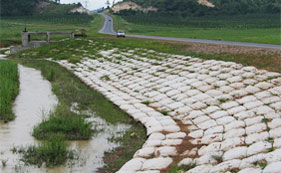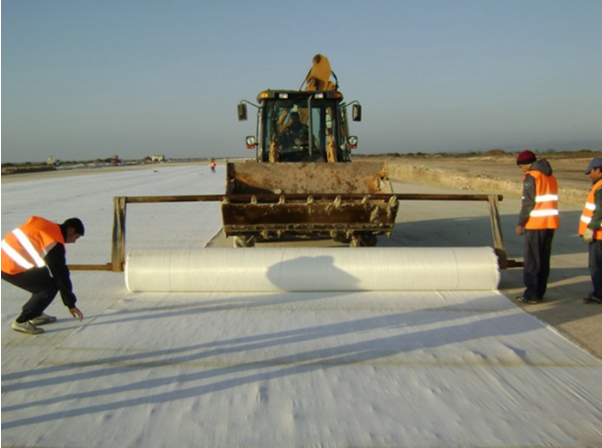
 Back to List
Back to List

Earthwork rollers are to be avoided before installation.
Geotextile rolls should be stacked in a level place without water, and not piled high
Above the height of the four rolls, and the roll identification sheet can be seen.
Geotextile rolls must be covered with opaque material to prevent uv aging.
During storage, the integrity of the label and the integrity of the data should be maintained.
Geotextile rolls must be protected from damage during transportation (including on-site transportation from material storage to work).
Geotextile rolls that have been physically damaged must be repaired.
Geotextile badly worn shall not be used.
Any geotextile in contact with the leaking chemical reagent is not allowed to be used in this project.
The laying method of geotextile
1. The cloth surface should be flat and properly deformed
2. The installation of filaments or short filaments geotextile is usually done by means of lapping, bonding and welding.
The width of stitching and welding is generally more than 0.1m, and the width of lapping is generally 0.2m.
Geotextile that may be permanently exposed should be welded or sewn together.
3. Suture of geotextile:
All stitching must be done in succession (for example, dots are not allowed).
The geotextile must be less strong before it can be stronger
150 mm.
A minimum distance of 25mm from the edge of the weave (the exposed edge of the material).
Seam good geotextile joints including 1 cable lock ロ even more method.
The thread used for suturing shall be a resin material with a smaller tension of more than 60N and with a chemical resistance and uv resistance comparable to or exceeding that of geotextile .
Any "leaky needles" in the stitched geotextile must be reconnected where affected.
Appropriate measures must be taken to prevent soil filling, particulate matter or foreign matter from entering the geotextile layer after installation.
The lapping of cloth can be divided into natural lapping, lapping or welding according to the terrain and using function.
4. During the construction, the geotextile above the geotextile shall be connected naturally, and the geotextile on the upper layer of the geomembrane shall be connected by joints or welded by hot air.
Hot air welding is the preferred connection method of filament yarns, that is, using hot air gun to heat two pieces of cloth at high temperature between the connections, so that part of the cloth reaches the state of melting, and immediately use fixed external forces to make it dry up together, in wet (rain and snow) weather can not be carried out
In the case of thermal bonding, the geotextile should adopt another suture connection method, namely, double suture connection with special sewing machine.
And the use of chemical uv - resistant suture.
The smaller width is 10cm for suture, 20cm for natural tracing, and 20cm for hot air welding
5, for the seam, the quality and geotextile should be the same dimensional, the suture should use chemical damage and uv irradiation energy
Stronger materials.
6. Geomembrane shall be laid after the completion of the geotextile laying is approved by the site supervision engineer.
7. The geotextile on the geomembrane shall be laid on the same surface after the geomembrane is approved by Party A and the supervisor.
8. The geotextile phase of each layer is numbered TN and BN.
9. The upper and lower layers of the film should be buried with the geotechnical film in the slot where there is a slot
Basic requirements for geotextile laying:
1. The joints shall intersect the slope line;
Where there is balance or possible stress at the foot of the slope, the horizontal seam must be more than 1.5m apart
2. On the slope, fix one end of the geotextile, and then put the coil down the slope to ensure that the geotextile remains tight
heart
3. All geotextile shall be pressed with sandbags which shall be used during the laying and retained to the layer above the laying.